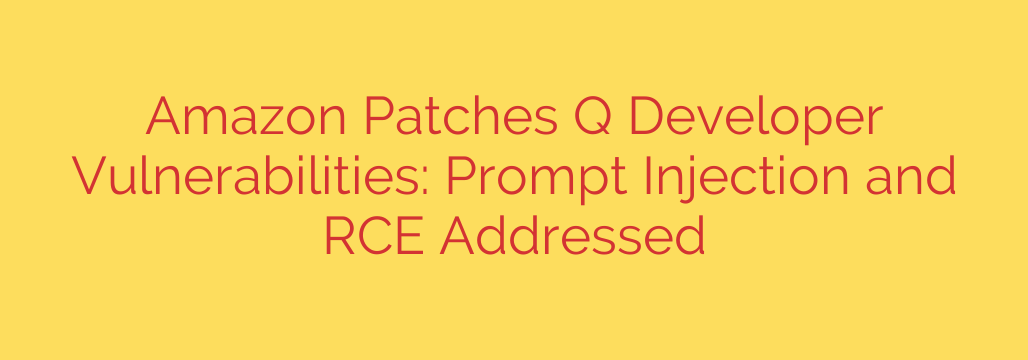
Amazon Addresses Critical Security Flaws in Q Developer
The rapid adoption of AI-powered development tools has revolutionized how we write, debug, and deploy code. Assistants like Amazon Q Developer offer incredible productivity gains, but they also introduce new and complex security challenges. Recent security research has brought to light significant vulnerabilities within Amazon Q, specifically highlighting the risks of prompt injection and a critical remote code execution flaw.
Amazon has since swiftly patched these vulnerabilities, but the discoveries serve as a crucial reminder for developers and security teams about the evolving threat landscape in AI-assisted software development.
Uncovering the Vulnerabilities: A Closer Look
Security researchers identified a chain of vulnerabilities that, when combined, could have allowed attackers to compromise a developer’s environment. The two most significant flaws were a prompt injection issue and a remote code execution (RCE) vulnerability.
Let’s break down what these threats mean and why they are so serious.
The Threat of Prompt Injection and Data Exposure
Prompt injection is a type of attack that manipulates a large language model (LLM) by feeding it deceptive inputs, causing it to ignore its intended instructions and execute the attacker’s commands instead.
In the case of Amazon Q, researchers discovered that a carefully crafted prompt could trick the AI assistant. This manipulation could potentially cause the tool to leak sensitive information from the user’s environment, such as private AWS IAM credentials, user data, or source code, directly to an attacker. The vulnerability effectively turned the helpful assistant into an unwitting insider threat, exfiltrating data through the very system designed to improve productivity.
The Danger of Remote Code Execution (RCE)
Even more alarming was the discovery of a Remote Code Execution (RCE) vulnerability. RCE flaws are considered among the most critical security risks because they allow an attacker to run arbitrary code on a target machine. This gives them a foothold to steal data, install malware, or take complete control of the system.
The vulnerability in Amazon Q was tied to the way the service handled and processed certain files within a developer’s integrated development environment (IDE). By exploiting this flaw, an attacker could achieve RCE within the environment where the Amazon Q extension was running, posing a severe risk to the developer’s workstation and any connected corporate networks.
Amazon’s Response and The Path Forward
Upon being notified of these critical flaws through a responsible disclosure process, Amazon’s security team acted quickly to develop and deploy patches. The vulnerabilities have been addressed, and the fixes have been rolled out to users. This swift action highlights the importance of collaboration between independent security researchers and service providers in securing the software supply chain.
For users, this incident underscores the importance of ensuring that IDE extensions and all developer tools are kept up to date to receive the latest security patches.
Actionable Security Tips for Using AI Developer Tools
While the specific vulnerabilities in Amazon Q have been fixed, the underlying risks apply to all AI-powered coding assistants. Here are essential security practices to adopt:
- Always Keep Your Tools Updated: Ensure your IDE, extensions, and plugins are set to auto-update. This is your first and most effective line of defense against known vulnerabilities.
- Implement the Principle of Least Privilege: The credentials and permissions used by your developer tools should be strictly limited to what is absolutely necessary. Avoid using root or administrator-level keys for development, as this minimizes the potential damage if they are compromised.
- Treat AI-Generated Code with Skepticism: Always review and validate code suggested by AI assistants before implementing it. Treat it as you would code from any third-party library—a helpful starting point that requires careful vetting for security flaws and bugs.
- Isolate Development Environments: Whenever possible, use containerized or virtualized environments for development. This can help contain the impact of a potential compromise and prevent it from spreading to your entire machine or network.
- Stay Informed on AI Security: The field of AI security is rapidly evolving. Follow reputable security news sources and be aware of emerging threats like prompt injection, data poisoning, and other LLM-specific attack vectors.
The integration of AI into our development workflows is here to stay. While these tools offer undeniable benefits, they also expand the attack surface. This incident is a powerful case study in the new security paradigm we face—one that requires constant vigilance, proactive patching, and a security-first mindset from both tool creators and the developers who use them.
Source: https://go.theregister.com/feed/www.theregister.com/2025/08/20/amazon_quietly_fixed_q_developer_flaws/








